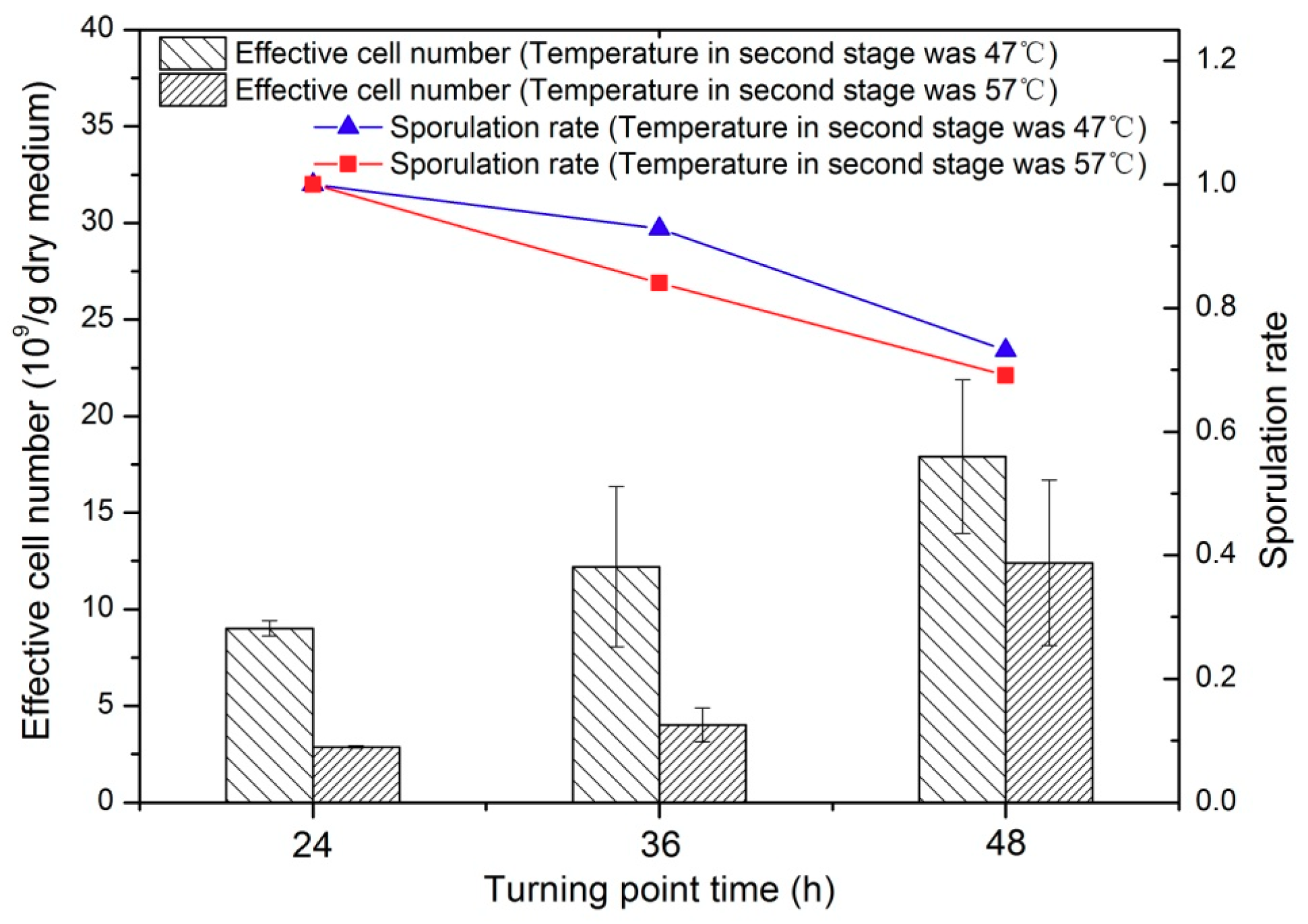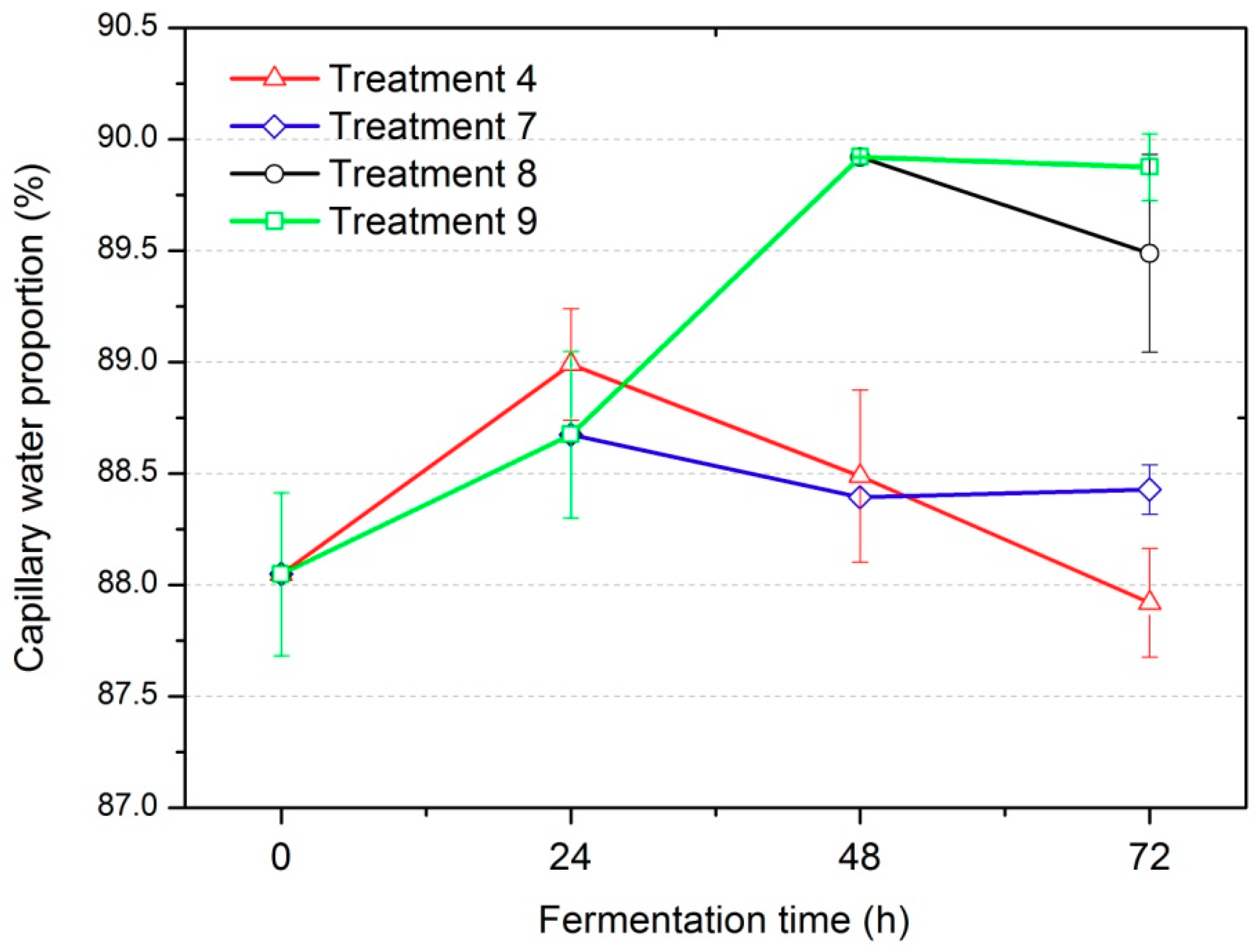Enhancement of Bacillus subtilis Growth and Sporulation by Two-Stage Solid-State Fermentation Strategy
Abstract
:1. Introduction
2. Materials and Methods
2.1. Microorganism and Medium
2.2. Two-Stage Solid-State Fermentation Strategy and Orthogonal Experimental Design
2.3. Measurement of Spore and Viable Cell Number
2.4. Glucose and Guanosine Triphosphate (GTP) Contents Changes in Medium
2.5. Low-Field Nuclear Magnetic Resonance (LF-NMR) Measurements
2.6. Statistical Analysis
3. Results and Discussion
3.1. Two-Stage Fermentation Optimization for Improving Effective Cell Number
3.2. Physical and Chemical Properties of Medium Changes during Two-Stage Fermentation Processes
3.2.1. Glucose Content Changes during Two-Stage Fermentation Processes
3.2.2. Water States and Microstructure of Medium Changes During Two-Stage Fermentation Processes
3.2.3. Relationship between GTP Content/Viable Cell Number with Sporulation Rate
3.3. Fermentation Kinetics and Sporulation Process in Two-Stage Fermentation
4. Conclusions
Author Contributions
Funding
Conflicts of Interest
References
- Yeo, S.; Lee, S.; Park, H.; Shin, H.; Holzapfel, W.; Huh, C.S. Development of putative probiotics as feed additives: Validation in a porcine-specific gastrointestinal tract model. Appl. Microbiol. Biotechnol. 2016, 100, 10043–10054. [Google Scholar] [CrossRef]
- Cutting, S.M. Bacillus probiotics. Food Microbiol. 2011, 28, 214–220. [Google Scholar] [CrossRef] [PubMed]
- Veen, H.V.B.-V.D.; Xie, H.; Esveld, E.; Abee, T.; Mastwijk, H.; Groot, M.N. Inactivation of chemical and heat-resistant spores of Bacillus and Geobacillus by nitrogen cold atmospheric plasma evokes distinct changes in morphology and integrity of spores. Food Microbiol. 2015, 45, 26–33. [Google Scholar] [CrossRef] [PubMed]
- Sen, R.; Babu, K.S. Modeling and optimization of the process conditions for biomass production and sporulation of a probiotic culture. Process Biochem. 2005, 40, 2531–2538. [Google Scholar] [CrossRef]
- Zhang, Y.C.; Jia, J.H.; Zheng, Y.; Chen, F.; Zeng, M.J.; Luo, J.M.; Wang, M. Optimization of sporulation condition of biocontriol bacteria B579 by two-step control strategy. Agric. Sci. Technol. Hunan 2011, 12, 249–252. [Google Scholar]
- Tišma, M.; Tadić, T.; Budžaki, S.; Ostojčić, M.; Šalić, A.; Zelić, B.; Tran, N.N.; Ngothai, Y.; Hessel, V. Lipase Production by Solid-State Cultivation of Thermomyces Lanuginosus on By-Products from Cold-Pressing Oil Production. Processes 2019, 7, 465. [Google Scholar] [CrossRef]
- Boratyński, F.; Szczepańska, E.; Grudniewska, A.; Skalny, B.; Olejniczak, T. A novel approach for microbial synthesis of enantiomerically pure whisky lactones based on solid-state fermentation. Molecules 2018, 23, 659. [Google Scholar] [CrossRef] [PubMed]
- Zhao, Z.-M.; Wang, L.; Chen, H.-Z. A novel steam explosion sterilization improving solid-state fermentation performance. Bioresour. Technol. 2015, 192, 547–555. [Google Scholar] [CrossRef]
- Zhao, Z.-M.; Wang, L.; Chen, H.-Z. Physical structure changes of solid medium by steam explosion sterilization. Bioresour. Technol. 2016, 203, 204–210. [Google Scholar] [CrossRef]
- Gianferri, R.; Maioli, M.; Delfini, M.; Brosio, E. A low-resolution and high-resolution nuclear magnetic resonance integrated approach to investigate the physical structure and metabolic profile of Mozzarella di Bufala Campana cheese. Int. Dairy J. 2007, 17, 167–176. [Google Scholar] [CrossRef]
- Han, M.; Wang, P.; Xu, X.; Zhou, G. Low-field NMR study of heat-induced gelation of pork myofibrillar proteins and its relationship with microstructural characteristics. Food Res. Int. 2014, 62, 1175–1182. [Google Scholar] [CrossRef]
- Felby, C.; Thygesen, L.G.; Kristensen, J.B.; Jørgensen, H.; Elder, T. Cellulose–water interactions during enzymatic hydrolysis as studied by time domain NMR. Cellulose 2008, 15, 703–710. [Google Scholar] [CrossRef]
- Tu, C.; Gao, Y.; Li, T.; Rui, X.; Li, W.; Wang, K.; Xiao, Y.; Dong, M. Study of Water Dynamics in the Soaking, Steaming, and Solid-State Fermentation of Glutinous Rice by LF-NMR: A Novel Monitoring Approach. J. Agric. Food Chem. 2015, 63, 3261–3270. [Google Scholar]
- Lima-Pérez, J.; López-Pérez, M.; Viniegra-González, G.; Loera, O. Solid-state fermentation of Bacillus thuringiensis var kurstaki HD-73 maintains higher biomass and spore yields as compared to submerged fermentation using the same media. Bioprocess Biosyst. Eng. 2019, 42, 1–9. [Google Scholar] [CrossRef] [PubMed]
- Lu, L.D. Studies on Screening, Identification, Solid-State Fermentation Optimization and Application Effect of Bacillus from Chicken Intestines. Master’s Thesis, Fujian Normal University, Fuzhou, China, 2010. [Google Scholar]
- Liu, Y.; Wang, L.; Chen, H.-Z. Two-steps gas double-dynamic solid-state fermentation enhances growth and spore production of Conithyrium minitans. Bioresour. Technol. 2018, 262, 235–241. [Google Scholar] [CrossRef] [PubMed]
- Guo, X.L.; Di, Y.N.; Wang, Y. Optimization of sporulation conditions of Bacillus subtilis. Soil Fertil. Sci. China 2012, 3, 99–103. [Google Scholar]
- Dong, C.; Chen, J. Optimization of process parameters for anaerobic fermentation of corn stalk based on least squares support vector machine. Bioresour. Technol. 2019, 271, 174–181. [Google Scholar] [CrossRef] [PubMed]
- Domínguez-Álvarez, J.; Mateos-Vivas, M.; Rodríguez-Gonzalo, E.; García-Gómez, D.; Bustamante-Rangel, M.; Zamarreño, M.-M.D.; Carabias-Martínez, R. Determination of nucleosides and nucleotides in food samples by using liquid chromatography and capillary electrophoresis. TrAC Trends Anal. Chem. 2017, 92, 12–31. [Google Scholar] [CrossRef]
- Shamsudin, S.N.; Rahman, M.H.F.; Taib, M.N.; Razak, W.R.W.A.; Ahmad, A.H.; Zain, M.M. Analysis between Escherichia Coli growth and physical parameters in water using Pearson correlation. In Proceedings of the 2016 7th IEEE Control and System Graduate Research Colloquium (ICSGRC), Shah Alam, Malaysia, 8 August 2016. [Google Scholar]
- Lund, D. Effects of Heat Processing on Nutrients. In Nutritional Evaluation of Food Processing; Springer Science and Business Media LLC: Dordrecht, Netherlands, 1988; pp. 319–354. [Google Scholar]
- Yan, S.; Wu, G. Bottleneck in secretion of α-amylase in Bacillus subtilis. Microb. Cell Factories 2017, 16, 124. [Google Scholar] [CrossRef]
- Ding, K.; Qiu, J.J.; Luo, W.G.; Li, W.; Li, Y.X.; Cao, P.H.; He, W.L.; Zhao, L.M.; Wang, Y.Q.; Zhang, C.J. Cloning, fusion expression of two cellulase genes from Bacillus subtilis and its enzymatic preperties. Chin. J. Anim. Nutr. 2017, 29, 2725–2733. [Google Scholar]
- Liu, Z.H.; Chen, H.Z. Biomass–water interaction and its correlations with enzymatic hydrolysis of steam-exploded corn stover. ACS Sustain. Chem. Eng. 2016, 4, 1274–1285. [Google Scholar] [CrossRef]
- Li, T.; Rui, X.; Li, W.; Chen, X.; Jiang, M.; Dong, M. Water Distribution in Tofu and Application of T2 Relaxation Measurements in Determination of Tofu’s Water-Holding Capacity. J. Agric. Food Chem. 2014, 62, 8594–8601. [Google Scholar] [CrossRef] [PubMed]
- Liu, Z.H.; Chen, H.Z. Periodic peristalsis releasing constrained water in high solids enzymatic hydrolysis of steam exploded corn stover. Bioresour. Technol. 2016, 205, 142–152. [Google Scholar] [CrossRef]
- Wang, L.; Sun, L.L.; Chen, H.Z. Factors and related strategies for improving the solid-state fermentation loading coefficient. Biotechnol. Bus. 2018, 65, 60–63. [Google Scholar]
- Weiss, N.D.; Felby, C.; Thygesen, L.G. Properties important for solid–liquid separations change during the enzymatic hydrolysis of pretreated wheat straw. Biotechnol. Lett. 2018, 40, 703–709. [Google Scholar] [CrossRef]
- Levdikov, V.M.; Blagova, E.V.; Young, V.L.; Belitsky, B.R.; Lebedev, A.; Sonenshein, A.L.; Wilkinson, A.J. Structure of the Branched-chain Amino Acid and GTP-sensing Global Regulator, CodY, from Bacillus subtilis. J. Boil. Chem. 2016, 292, 2714–2728. [Google Scholar] [CrossRef] [PubMed]
- Narula, J.; Kuchina, A.; Lee, D.-Y.; Fujita, M.; Süel, G.M.; Igoshin, O.A. Chromosomal arrangement of phosphorelay genes couples sporulation and DNA replication. Cell 2015, 162, 328–337. [Google Scholar] [CrossRef] [PubMed]
- Piggot, P.J.; Hilbert, D.W. Sporulation of Bacillus subtilis. Curr. Opin. Microbiol. 2004, 7, 579–586. [Google Scholar] [CrossRef]
- Fu, X.M.; Zhao, S.M.; Liang, Y.X.; Ge, X.Y. The optimization of solid-state fermentation process for high-yield spore production of a feeding Bacillus subtilis. Feed Industry 2010, 22, 43–46. [Google Scholar]
- Joshi, S.; Bharucha, C.; Desai, A.J. Production of biosurfactant and antifungal compound by fermented food isolate Bacillus subtilis 20B. Bioresour. Technol. 2008, 99, 4603–4608. [Google Scholar] [CrossRef]
- Chen, H.Z.; He, Q. A novel structured bioreactor for solid-state fermentation. Bioprocess Biosyst. Eng. 2013, 36, 223–230. [Google Scholar] [CrossRef] [PubMed]







| Treatment Number | A (Mn2+ Content) (mg MnSO4/g Dry Medium) | B (Turning Point Time) (h) | C (Temperature in Second stage) (°C) | Effective Cell Number a (109/g Dry Medium) |
|---|---|---|---|---|
| 1 | 0.0 | 24 | 37 | 9.36 ± 0.51 |
| 2 | 0.0 | 36 | 47 | 12.2 ± 4.14 |
| 3 | 0.0 | 48 | 57 | 12.4 ± 4.28 |
| 4 | 0.49 | 24 | 47 | 9.01 ± 0.40 |
| 5 | 0.49 | 36 | 57 | 4.02 ± 0.87 |
| 6 | 0.49 | 48 | 37 | 10.1 ± 0.20 |
| 7 | 4.9 | 24 | 57 | 2.88 ± 0.06 |
| 8 | 4.9 | 36 | 37 | 13.8 ± 3.05 |
| 9 | 4.9 | 48 | 47 | 17.9 ± 3.98 |
| K1 | 34.0 | 21.3 | 33.3 | |
| K2 | 23.1 | 30.0 | 39.1 | |
| K3 | 34.6 | 40.4 | 19.3 | |
| k1 | 11.3 | 7.10 | 11.1 | |
| k2 | 7.70 | 10.0 | 13.0 | |
| k3 | 11.5 | 13.5 | 6.43 | |
| R | 3.80 | 6.40 | 6.57 | |
| Order | RC > RB > RA | |||
| Factors | Sum of Squares (1019) | Degree of Freedom | Mean Square (1019) | F-ratio | Significance |
|---|---|---|---|---|---|
| A (Mn2+ content) | 5.54 | 2 | 2.77 | 1.926 | 0.192 |
| B (Turning point time) | 12.28 | 2 | 6.14 | 4.274 | 0.042 |
| C (Temperature in second stage) | 13.76 | 2 | 6.88 | 4.790 | 0.032 |
| Error | 15.80 | 11 | 1.44 |
| Variables Relationship | Correlation Coefficient, r | Significance |
|---|---|---|
| Capillary water proportion vs. effective cell number | 0.674 | * * |
| Capillary water proportion vs. viable cell number | 0.694 | * * |
| Capillary water proportion vs. spore number | 0.665 | * * |
© 2019 by the authors. Licensee MDPI, Basel, Switzerland. This article is an open access article distributed under the terms and conditions of the Creative Commons Attribution (CC BY) license (http://creativecommons.org/licenses/by/4.0/).
Share and Cite
Zhao, Z.-M.; Xi, J.-T.; Xu, J.-F.; Ma, L.-T.; Zhao, J. Enhancement of Bacillus subtilis Growth and Sporulation by Two-Stage Solid-State Fermentation Strategy. Processes 2019, 7, 644. https://doi.org/10.3390/pr7100644
Zhao Z-M, Xi J-T, Xu J-F, Ma L-T, Zhao J. Enhancement of Bacillus subtilis Growth and Sporulation by Two-Stage Solid-State Fermentation Strategy. Processes. 2019; 7(10):644. https://doi.org/10.3390/pr7100644
Chicago/Turabian StyleZhao, Zhi-Min, Jun-Ting Xi, Ji-Fei Xu, Li-Tong Ma, and Ji Zhao. 2019. "Enhancement of Bacillus subtilis Growth and Sporulation by Two-Stage Solid-State Fermentation Strategy" Processes 7, no. 10: 644. https://doi.org/10.3390/pr7100644
APA StyleZhao, Z. -M., Xi, J. -T., Xu, J. -F., Ma, L. -T., & Zhao, J. (2019). Enhancement of Bacillus subtilis Growth and Sporulation by Two-Stage Solid-State Fermentation Strategy. Processes, 7(10), 644. https://doi.org/10.3390/pr7100644




